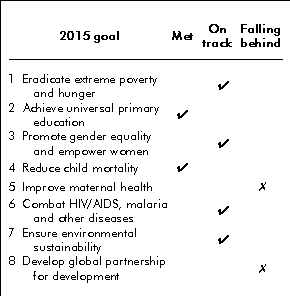Did You Know…?
Did You Know? More than 190 countries, including Mexico, have now signed up to the UN Millennium Development Goals, originally agreed in the year 2000.
There are eight key goals (see table) and Mexico is well on its way to meet most of them. Specific targets that Mexico has not yet reached include an increase in the proportion of GDP that corresponds to the poorest 20% of the population (goal 1); an increase in the number of women in government (goal 3); a further decrease in maternal mortality (goal 5); an increase in forested area (goal 7) and an improved employment rate for young people aged 15–24 (goal 8).

There are many possible indicators of quality of life. One measure commonly used is life expectancy at birth. How long do Mexicans live? The 20th century brought dramatic increases in longevity. Average life expectancy rose from under 30 years at the beginning of the 20th century to 38 by 1930. From there it went up to 50 by 1950 and reached 62 by 1970. By 2000 it was 72, almost double the 1930 value. Women live longer than men. Today, life expectancy for Mexican women is about 77; that for men is roughly 71 years. In the future, Mexican longevity is expected to increase at about 2.5 years per decade. This is not as rapid as in the past, but still a significant rate of increase.
It is much harder to find a reliable indicator of a population’s overall health. The most common indicator is infant mortality, the percentage of babies born who die before their first birthday. In respect to this indicator, Mexico has made impressive progress: its infant mortality rate dropped from 7.5% in 1970 to 2.0% by 2005. More improvements are expected in the years ahead.
These indicators suggest that Mexicans are living longer and healthier lives than they did in past decades. How does Mexico compare to other major countries? Though Mexico trails Canada, the USA, and Argentina, it is slightly ahead of Brazil, China, and the weighted average for Latin America. Mexico is significantly ahead of Russia, the world average, and its southern neighbor Guatemala.
The Millennium goals give us a useful framework for assessing improvements in several key aspects of development but they don’t tell the whole story.
For instance, the first UN development goal concerning poverty and hunger clearly involves programmes to counter malnutrition, or more accurately to counter under-nutrition. While malnutrition is commonly associated principally with people not getting enough to eat, potentially resulting in them suffering from vitamin-deficiency diseases and facing an increased risk of starvation, the concept of malnutrition also includes, at the other end of the spectrum, over-nutrition and issues related to obesity.
So, just how prevalent is malnutrition in Mexico? A National Nutrition Survey in 1999 of 23,000 households found that the type and incidence of malnutrition in Mexico had changed dramatically in a single generation. Rates of under-nutrition (insufficient intake of calories and/or vitamins for good health) have declined. This has helped Mexico meet one of the key UN targets — that of a 50% reduction between 1990 and 2015 in the proportion of children suffering from hunger (under-nutrition) with several years to spare. Other figures support Mexico’s progress in reducing undernutrition. Severe undernourishment (as defined by the World Health Organization) among children fell from 6% in 1988 to 2% in 1999.[ii] The proportion of children under 5 years of age identified as underweight has been reduced from 14% in 1988 to 5% in 2006.[iii]
However, the 1999 National Nutrition Survey simultaneously revealed that rates of overweight and obesity, differing degrees of over-nutrition defined by an individual’s body mass index (a measure of weight adjusted for height) had soared. The percentage of women considered obese rose 160% between 1988 and 1999. In 1999, 59% of women and 55% of men were either overweight or obese; by 2008, the figures were 64% and 60% respectively. Only the USA has higher rates of obesity. If trends persist, Mexican health officials believe that Mexico could actually overtake the USA in obesity rate within a decade. Equally alarmingly, the rate of childhood obesity in Mexico is also increasing rapidly. A 2002 study found that 30% of elementary school children in Mexico City and 45% of adolescents were either overweight or obese.
This increase in over-nutrition has led to rapid rises in diet-related chronic diseases such as diabetes and cardiovascular disease. The overall effects of diseases on a country’s population can be assessed by working out the disability-adjusted life years (DALY), the years of expected life lost through disease or premature death. In Mexico, the DALY lost to diseases normally thought to be more typical of the developed world — such as diabetes, heart attacks and strokes — is estimated to be three times greater than the DALY stemming from childhood and maternal under-nutrition.[iv]
Mexico has passed rapidly through a “nutrition transition”. The traditional Mexican diet was based on corn and beans, supplemented by fruits and vegetables, with relatively little meat and dairy products. Over a 15-year period, the average Mexican ate 29% less fruits and vegetables and 6% more carbohydrates, while consuming 37% more soft drinks. In fact, Mexicans enjoy the dubious distinction of being the world’s second greatest consumers of soft drinks (after USA), downing 150 liters a year on average. White bread is replacing tortillas, fast food is replacing home cooking.
This nutrition transition, together with a more sedentary lifestyle, has fuelled a “disease transition”, characterized by a shift from high mortality due to infectious diseases to high mortality from non-communicable chronic diseases. Mexico has the highest rate of diabetes in the world, more than 11%.[v] The total number with diabetes has risen seven fold since 1990. Diabetes is now the leading cause of death, and costs the country more than $300 million annually, one-third of the total public health care budget.
Sources
- [i] www.nationmaster.com/graph-T/hea.
- [ii] Lloyd Mexican Economic Report, August 2000.
- [iii] Gabinete de Desarrollo Humano y Social / Comisión Intersecretarial de Desarrollo Social. 2006. Los Objetivos de Desarrollo del Milenio en México: Informe de Avance 2006.
- [iv] Jacoby, E. R. 2004. PAHO regional consultation of the Americas on diet, physical activity and health. Food and Nutrition Bulletin 25 (2): 172-174
- [v] Elisabeth Malkin. Mexico Confronts Sudden Surge in Obesity, New York Times, 29 June 2005.
This article is based on a chapter in a forthcoming book about the geography of Mexico jointly written by Dr. Richard Rhoda and Tony Burton.

